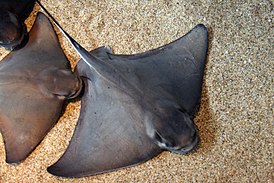Eagles [1] ( lat. Myliobatis ) is a genus of slopes of the caudal- order detachment. The name comes from the words ancient-Greek. μύλος - “crusher”, “mill” [2] and lat. batis - “scat” [3] . They live in all subtropical waters except for the central part of the Pacific Ocean .
| Eagles |

California bracken |
| Scientific classification |
|---|
| No rank : | Bilateral symmetric |
|
| International Scientific Name |
|---|
Myliobatis Cuvier (ex. Duméril, AMC ), 1816 |
|
Content
Pectoral fins of these rays have the shape of "wings" and grow together with the head, forming a diamond-shaped disk, the width of which exceeds the length. The wide head protrudes beyond the edges of the disk. There is one dorsal fin. The characteristic shape of the flat snout, formed by the accreted front edges of the pectoral fins, resembles a duck nose [4] . The thin tail is approximately equal in length to the disc. On the tail there are 1-2 poisonous spikes. Tail fin absent. Behind the eyes are the squiggles . On the ventral side of the disc are nostrils, a mouth, and 5 pairs of gill slits . The teeth form a flat, rubbing surface consisting of 7 rows of plates. The side plates are adapted for crushing the shells of mollusks and shells of crustaceans, which, along with small bony fishes, form the basis of the diet of bracken. The maximum length of these slopes reaches 150 cm [5] .
The genus currently includes 12 existing species:
- Myliobatis aquila ( Linnaeus , 1758) - Common Bracken or Sea Eagle
- Myliobatis australis Macleay, WJ , 1881 - Australian Bracken
- Myliobatis californica TN Gill , 1865 - California bracken
- Myliobatis chilensis Philippi {Krumweide} , 1892
- Myliobatis freminvillii Lesueur , 1824 - Eastern American Bracken
- Myliobatis goodei Garman , 1885
- Myliobatis hamlyni JD Ogilby , 1911
- Myliobatis longirostris Shelton P. Applegate & John Edgar Fitch, 1964
- Myliobatis peruvianus Garman , 1913 - Peruvian Bracken
- Myliobatis ridens Ruocco, Lucifora, Díaz de Astarloa, Mabragaña & Delpiani, 2012
- Myliobatis tenuicaudatus Hector , 1877
- Myliobatis tobijei Bleeker , 1854
And 16 extinct:
- † Myliobatis dixoni Agassiz, 1843
- † Myliobatis fastigiatus Leidy, 1876
- † Myliobatis faujasi Agassiz, 1843
- † Myliobatis frangens Eastman, 1904
- † Myliobatis gigas Cope, 1868
- † Myliobatis holmesii Gibbes, 1849
- † Myliobatis intermedius Dartevelle & Casier, 1943
- † Myliobatis jugosus Leidy, 1876
- † Myliobatis magister Leidy, 1876
- † Myliobatis nzadinensis Dartevelle & Casier, 1943
- † Myliobatis oligocaena Leriche, 1910
- † Myliobatis pachyodon Cope, 1868
- † Myliobatis raouxi Arambourg, 1952
- † Myliobatis striatus Agassiz, 1843
- † Myliobatis sulcidens Dartevelle & Casier, 1943
- † Myliobatis vicomicanus Cope, 1868
Extinct species of bracken lived from the Cretaceous to the Quaternary (70.6–0.012 million years ago). Fossils of these fish are found all over the world [6] .
